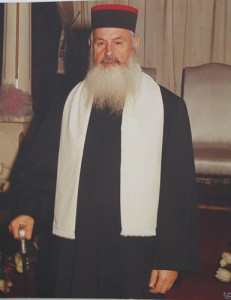 Print this Article
Print this Article

Golden Roots
One of the great luminaries of Moroccan Jewry in recent times was the revered Rav of Yerushalyim, Ribbi Shalom Messas זצ”ל. Ribbi Shalom was born in 1909 to his father Ribbi Mimoun and mother Rahel in Meknes, a city steeped in scholarship and Yir’at Shamayim, that has produced outstanding Hachamim for many generations. Ribbi Mimoun was the author of Otzrot Shamayim and son of the first Ribbi Shalom Messas, author of Divre Shalom, scion of the Messas and Berdugo dynasties of scholars with roots in Spain and Portugal.
The young Shalom showed great promise at a very early age, as he studied diligently under his teacher Ribbi Yitzhak Assabag זצ”ל.
Soon after tending to the publishing of the writings of his great-grandfather (Ribbi Refael Berdugo זצ”ל, nicknamed “HaMal’ach”) on the Talmud, titled Sharvit HaZahav, Ribbi Shalom went on to author his own Hiddushim in his first Sefer Mizrah Shemesh, written at the tender age of 17 and published when he was 25 years old. In his introduction to this work he testifies: “throughout my youth, I have not dealt with or even looked at money whatsoever, as I was so engrossed with the love of the holy Torah”.
The Rising Sun
Ribbi Shalom married his wife Jamila, daughter of Hacham Moshe Alchareiyef זצ”ל. After being entrusted with leading the Talmud Torah of Meknes, which boasted around 2000 students, and heading Yeshivat Keter Torah which he established, Ribbi Shalom was called to serve as a Dayan in Casablanca. He was eventually appointed to be the Chief Rabbi of Casablanca and subsequently the Chief Rabbi of all Morocco.
As Chief Rabbi of Morocco, Ribbi Shalom enjoyed a very close relationship with the King of Morocco, Hassan the Second, who vested in him the authority to judge according to Halacha and fortify the standards of Kashrut in the country. Twice a year, Ribbi Shalom would be summoned to the king’s palace to bestow upon him the Hacham’s blessings.
From Meknes to Yerushalayim
In 1978, then-Israeli Chief Rabbi, Hacham Ovadia Yosef זצ”ל asked Ribbi Shalom to come to the holy city of Yerushalyim and serve as its Sephardic Chief Rabbi – a position which he held for 26 years, until his passing. When he departed for Eretz Yisrael, Rabbi Messas was escorted to the airport by Morocco’s King Hassan himself, who requested that the Rabbi bless him one last time before his departure.
During his tenure as Rav of Yerushalayim, Ribbi Shalom wrote many Teshuvot to the great Poskim of our generation such as Hacham Ovadia Yosef זצ”ל, Rav Yosef Shalom Elyashiv זצ”ל, the Tzitz Eliezer and more. Although he had many Halachic disputes with Hacham Ovadia, they admired each other greatly as is evident from the countless times which they quote each other in their many Halachic works. It is told that Hacham Ovadia would not permit an Aguna before first consulting with Ribbi Shalom.
A Beacon of Halacha
Ribbi Shalom was an extremely prolific author and Posek. He was very careful to preserve the Sephardic customs, and would often invest long days and nights in order to be able to establish a Minhag in accordance with Halacha.
He would also not hold back from answering any of his critics, and often write back and forth five or six times to those who questioned his Pesakim, even if they were younger Talmide Hachamim. Hacham David Yosef שליט”א, son of Hacham Ovadia, related that he once wanted to argue a matter of Halacha with Ribbi Shalom and received a warning from his father: “When you argue with Rav Messas, make sure to review your claims ten times!”
The many Sefarim Ribbi Shalom wrote in Halacha, Darush and other areas of Torah span his lifetime, from his early youth until a year before his passing. They include: Mizrah Shemesh, Tevu’ot Shamesh, Shemesh U’Magen and many more. He also invested tremendous efforts in publishing the manuscripts of the scholars of Morocco of the previous generations.
The Sun Sets
Rabbi Shalom Messas, passed away on Shabbat HaGadol in the year 5763 (2003), at the age of 94. Tens of thousands of people flocked from all over Eretz Yisrael and abroad to attend his Levaya, and he was buried in Har HaMenuhot in Yerushalayim. His Sefarim still serve as an enlightening resource to many Talmide Hachamim across the globe, and many communities have held on to precious and ancient Minhagim in accordance with his Pesakim.